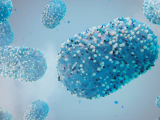In a study today in Morbidity and Mortality Weekly Report, researchers detail 83 confirmed monkeypox cases among US children and teens, noting household contact in younger kids and sex in teens as the major risk factors.
From May 17 to Sep 24, a total 25,038 Americans were diagnosed as having monkeypox, the report said, the vast majority being adult men who have sex with men (MSM).
Pediatric cases 0.3% of total
Researchers from the Centers for Disease Control and Prevention (CDC) and their state partners confirmed that 83 cases, or 0.3% of the national total, were among children 18 and younger, including 28 children aged 0 to 12 years and 55 adolescents aged 13 to 17 years.
Among children in the younger age-group, 64% were boys, and most had direct skin-to-skin contact with an adult with monkeypox who was caring for the child in a household setting, the authors said.
Among the teens, 89% were boys, and 66% were presumed to contract the virus during MSM sexual contact. Only 16 girls were confirmed to have contracted the virus.
Black children made up 47% of the 83 patients, with Latinos making up 35%.
"Most (89%) were not hospitalized, none received intensive care unit (ICU)–level care, and none died. Monkeypox in children and adolescents remains rare in the United States," the authors said.
Young kids most often exposed at home
Among 20 children aged 0 to 12 (71%) with available exposure data, 19 were exposed in the household setting, the authors said. Among 17 of these children, the reported exposure was direct skin-to-skin contact that routinely occurs between a child and an adult caregiver.
In one case fomite transmission—towels shared with a caregiver with monkeypox—was the suspected route of exposure for a young child.
Among 35 adolescents (64%) with available exposure data, 32 were boys with direct skin-to-skin sexual contact as the presumed mode of spread: 23 (72%) reported male-to-male sexual contact, 4 (13%) reported male-to-female sexual contact, and 5 (16%) reported sexual contact with a person whose sex was not specified.
No patient ages in the younger group developed anal-genital lesions; instead most lesions were on the trunk. Three children in this group were hospitalized. For teens, 60% had rash on the genitals. Six adolescent patients (11%) were hospitalized, and one teen received a new diagnosis of HIV infection during hospitalization.
In an important finding, 10 instances were investigated in which a child or adolescent with monkeypox attended a child care facility (2) or school (8) while symptomatic, but no secondary transmission in these settings took place.
"The absence of known secondary transmission in schools and child care facilities despite the presence of symptomatic persons in these settings suggests that widespread child-to-child transmission might be unlikely," the authors said. "Regardless of age, contacts of persons with monkeypox should be monitored."
The CDC yesterday reported 127 new monkeypox cases, raising the national total to 28,619.





















